Buying a used boat: Own inspection or surveyor? What you need to look out for
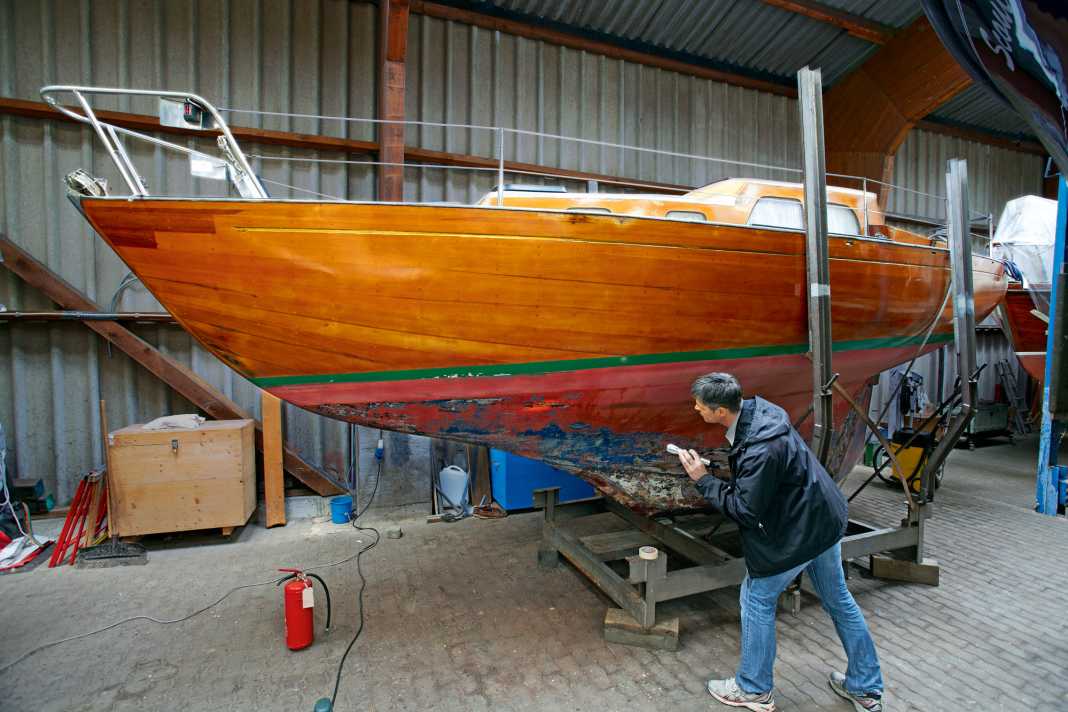





A worthwhile bargain or a permanent construction site that devours huge sums of money? As soon as a particular used boat is shortlisted, it is important to identify its weak points - before signing the contract.
Experienced sailors naturally find this easier than first-time buyers, as they can draw on their wealth of experience and quickly identify critical points. At least when it comes to comparable used boats that they have already sailed themselves.
What's more, the more years a boat has been in the water, the higher the repair costs following the purchase will usually be - especially if the seller hasn't had much interest in keeping the boat in good condition recently. Keyword refurbishment backlog.
If you want to avoid this, you need to find a second-hand boat whose owner has regularly invested a lot of work and effort in his hobby. So ask specifically when which work was last carried out. Ideally, certain parts and equipment such as the engine, sails or rigging should have been replaced not too long ago. Although this drives up the price, it minimises the risk of an unforeseen cost explosion after the purchase.
When is an expert worthwhile when buying a used boat?
If you are not sure whether your assessment is correct, it is better to hire an expert. They will take a close look at the property of your choice with an expert eye and then provide a cost estimate for any repairs that may be required. A list of experts can be found on the Website of the German Boat and Shipbuilders' Association dbsv.de.
Investing in an expert can be more than worthwhile. An expert opinion generally costs no more than 1,000 or 2,000 euros - not a large sum in relation to possible damage that could be overlooked.
An assessment in the water and on land would be ideal"
So says Uwe Gräfer from Hanse Ingenieurbüro Sportboot-Sachverständige. Himself the owner of a classic GRP yacht, Gräfer has been providing boat expertises for insurance companies, shipyards and owners for years. His opinion is also increasingly sought by buyers of used boats. "In my experience, this is always worthwhile," says Gräfer. He often comes across price-reducing factors that buyers and sellers overlook - and which quickly exceed his own invoice amount.
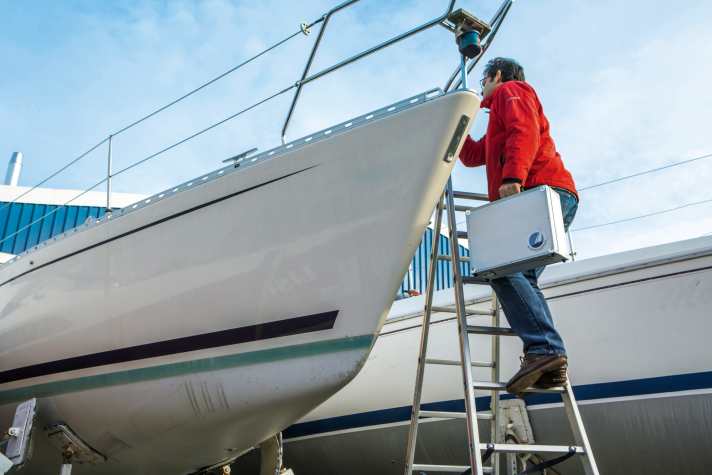
Even if many of the typical weaknesses of a used boat become apparent to any reasonably experienced sailor on closer inspection - who is objective when standing on the deck of their supposed dream boat? And who goes to work with an endoscope and moisture meter when a survey is due?
The expert strongly advises a test run with the boat of desire. Structural defects are best recognised under load, which also applies to the engine in a figurative sense. It would therefore be ideal to crane the boat after sailing and only inspect it for laminate moisture after one or two days of drying on land, says Gräfer. However, a careful inspection on land or at the berth in the water also provides many important findings.
Viewing a used boat
First of all, nobody should go out to buy a second-hand boat on their own. It is best to try to take someone with you who is known and knowledgeable, but above all emotionally uninvolved. This quasi-lawyer should ask the - possibly unpleasant - questions on site that the owner-to-be might overlook due to their rose-tinted spectacles. Being hopelessly in love with the property makes rational decisions impossible.
And also plug in your smartphone. The pictures can not only be shown to other sailing enthusiasts. They also help to compare several inspected used boats with each other. During the inspection of the used boat, the mobile phone can also be used to inspect inaccessible areas, such as the underside of the engine.
During the viewing, you should definitely take your time, lie in the bunks for a while, try everything out and start the machine. It is essential to agree - and check - that the engine is cold before it is started in the presence of the prospective buyer. This is the only way to ensure flawless cold start behaviour. And that is important.

Important: a test drive before buying a used boat
As many problems only occur under load, a test drive with the used boat on the water is obligatory. Don't hesitate to run the engine at high revs for a few minutes. Is it overheating? Sails, heating, cooker, toilet, refrigerator, electronics - everything should be tested. Once the boat is ashore, discuss the possibility of a test drive. This can often be done by concluding a purchase contract subject to a faultless sea trial. If everything works during the sea trial, the boat is bought. A seller will agree to this if the used boat is in good condition.
It is also advisable to ask lots of questions and talk to neighbours or the harbour master. Can the regular maintenance of the second-hand boat be documented with invoices? You should also approach the service company and ask whether any other work has been carried out on the boat. This will give you an overall picture of the boat step by step.
You need time for this. You can ask sellers or brokers who are in a hurry or are hectic to keep calm. If they continue to put pressure on the prospective buyer, refrain from buying a used boat. Those who push may be trying to hide something.
Checklist: What you should check when buying a used boat
We also show the most important points to check during the inspection in the picture gallery above!
Hull
- Osmosis test
Buyers are most afraid of purchasing a second-hand boat with osmosis. No wonder, the professional hull restoration of a ten-metre yacht can easily cost 10,000 euros. However, there is no need to be overly concerned. Only in a few, very advanced cases does osmosis actually impair the seaworthiness of a ship. In the Netherlands, for example, it is almost normal. It occurs quite frequently there due to the freshwater areas. Owners often continue to sail their boats unimpressed for decades and often only treat the most pronounced blisters selectively during winter storage. Nevertheless, you should of course look very carefully for blisters on the hull or repaired areas when inspecting a boat. The greatest certainty is provided by a moisture measurement. Elevated values are at least an indication of impending or even existing osmosis. This is always a good reason to refrain from buying or at least to renegotiate the price. - Keel suspension
It is subject to high stresses, not only at sea, but also in winter storage when the ship is parked on its keel. Stress cracks can then open up, which are not visible in the water during the season. The angle laminates should also be checked for cracks. - Rudder blade and skeg
Both are sometimes hollow and laminated from two parts. The bondings leak over the years and water seeps in. So if moisture forms on the edges or if repaired drill holes are visible on the lower edges, caution is advised. - Rudder bearing
Check that the upper and lower rudder bearings are intact and not worn out.
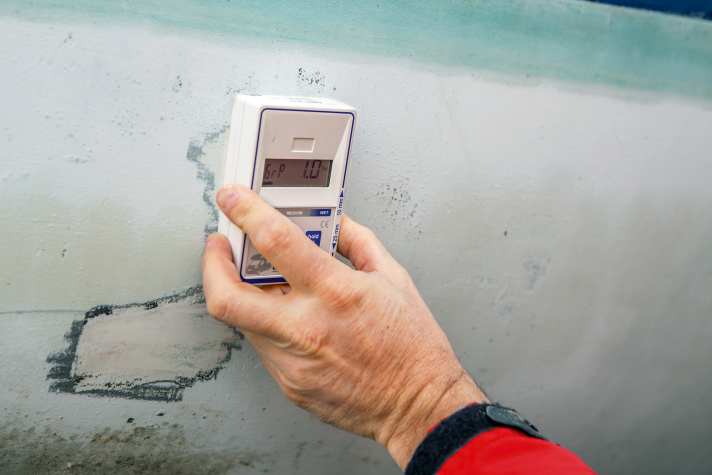
Deck and superstructure
- Quirks in the deck
In most cases, they can be repaired with gelcoat. However, it should be borne in mind that the colour tones are often difficult to match if the gelcoat has faded. And a deck paint job for a ten-metre ship can easily cost 12,000 euros or more. - Deck coverings
On GRP yachts, they often consist of gelcoat studs embedded in the mould. These wear out over the years or have even been painted over. As a result, the deck loses its slip resistance. This is often not noticeable when inspecting the boat in the hall, but it is during a test sail. The prices for a new deck vary between a few euros per square metre and up to 1,000 or significantly more euros per square metre for a new teak deck. - Teak decks
They require a lot of maintenance and often leak over the years. Once they have been sanded down so far that the screw heads are visible or the joints are protruding, they need to be replaced. To estimate the thickness of the wood, it helps to turn a screw into a wooden plug and then remove it from the deck. - Stress cracks on the railing supports
They can be harmless traces of an unsuccessful airlock manoeuvre - or an indication of structural damage, even delamination. - Balsa wood core
Sometimes this is downright composted as a result of leaking screw connections and water ingress. Extensive refurbishment of the deck is then unavoidable. In particular, check the tightness of the screw connections and scrutinise the hull-deck connection. - Creaks
Decks or superstructures that creak in noticeable places under load should also make you suspicious. - Tiller and steering wheel
Should be checked for play. If the wheel can be moved several centimetres without the rudder following, the cable transmission may be loose, the rudder arm may be worn out or the blocks may be worn.
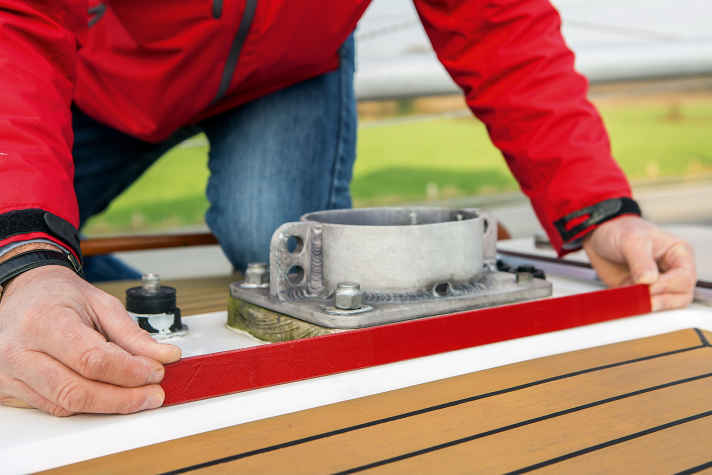
Rig and sail
- Shrouds and stays
They should be replaced every ten years. Weak points become apparent at an early stage, for example rust on the pressings. Rubber covers over the shroud tensioners encourage corrosion as they create a damp environment. - Current asset
If the cordage is only weathered, a wash in the washing machine can bring back the old colours. To do this, wash at 30 degrees with a mild detergent, Do not use fabric softener! However, if there are chafe marks, they need to be replaced. Even for polyester lines on a ten-metre yacht, this can quickly add up to over 1,000 euros. - Winches
If they are too small or there are too few of them, sooner or later there will be a desire to replace them. Large investments are then also required. If the winches are merely stiff, they can be maintained quite easily. Look out for branded products that still exist today. Lewmar and Andersen still supply maintenance kits for 30-year-old models. - Sail
How you judge them is a question of what you want. Anyone who sails regattas will turn up their nose at a five-year-old cloth, whereas cruising skippers are often satisfied even with sails that are ten years old. Mould and rust stains indicate poor and damp storage, but they do not necessarily impair the function. When making their choice, buyers should be aware that the rig and sails are the main propulsion system of the yacht and that they must be able to rely on them in an emergency. If, for example, the engine is too weak to tack in a leeward situation, the yacht should be able to tack free. This can quickly go wrong in strong winds with a badly worn or flimsy cloth.
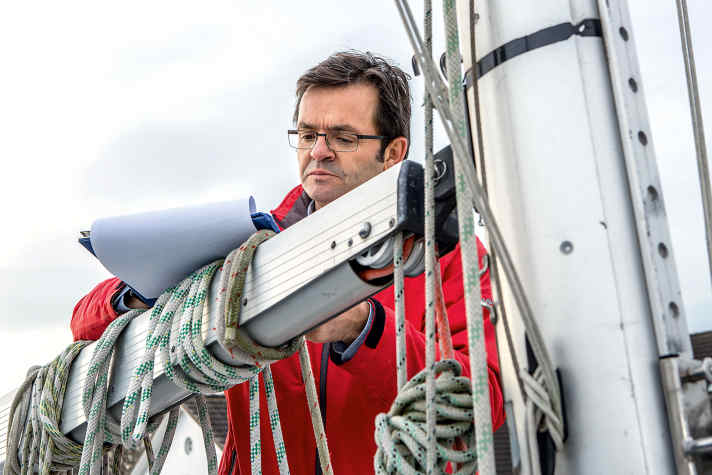
Below deck
- Gas system
It is essential to check that it has been installed correctly and to ask when it was last depressurised. The rubber hoses become hard and porous and should therefore be replaced every ten years. - Drinking water tanks and boilers
They are germ cells for legionella. Therefore, ask when they were last cleaned and the hoses last replaced. In many cases, the first drinking water hoses are still on board and are already discoloured black on the inside. - Refrigerator
Switch it on at the start of the inspection and check the cooling capacity later. If it is no longer cooling properly but the compressor is working, this may be due to a lack of coolant. - Valves
Sometimes a ship only floats because an old, hardened rubber hose is held on the sea valve by a rusty hose clamp. Should it come loose, it must be possible to close the valves. However, this is rarely the case on older yachts. Cockpit bilge valves, for example, are often not closed for decades and become bogged down. Replacing them is expensive and not all materials are suitable for use in seawater
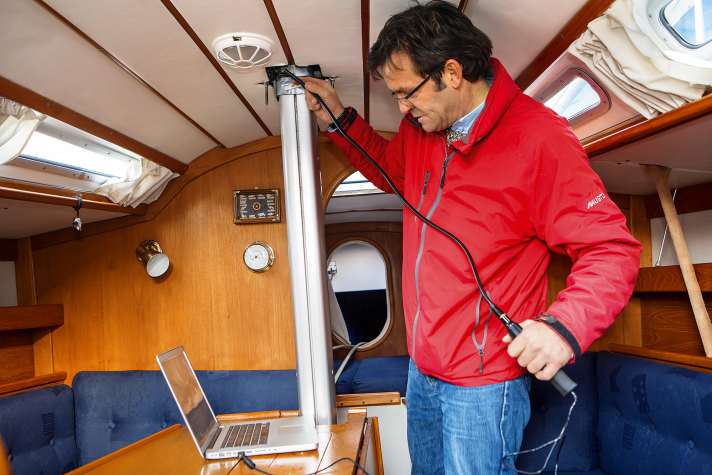
Machine
- Propeller shaft
Shafts can warp due to long periods ashore. Therefore, when inspecting the boat, turn the propeller and look along the shaft to see if it is warped. Replacement is usually only possible by removing the engine. - Shaft tube and bearing
They should also be checked for play. Up to half a millimetre is normal. - Saildrive
Check cuffs for porosity. They must be replaced after ten years. - Shaft seal
Check whether it is maintenance-free or whether it is an old-fashioned stuffing box with a grease gun. - Outboard motor
Check it carefully as well. Is the propeller suitable for the drive purpose? If it is a shaft motor, check the shaft for corrosion, as pitting can occur due to permanent storage in water.
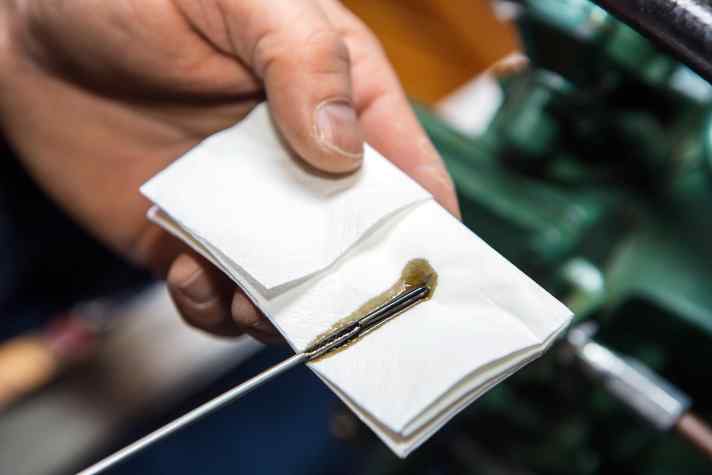
Electrics
- Cabling
On delivery, many ships are only equipped with a basic installation and a few unused cables for future consumers. When electronic equipment is added years later, plus and minus have to come from somewhere. It is not uncommon for two cables to simply be branched off at other consumers. - Fuses
During the inspection, you should at least take a look behind the switch panel. If cables are hanging loose, there is reason to fear the worst - short circuits can occur in rough seas. Check how the consumers are fused. Fuses are outdated, circuit breakers should be standard. Also check whether the cable dimensions are still sufficient despite the increase in consumers. - Switch panel
A new switch panel with circuit breaker can be realised with an investment of just over 100 euros. However, anyone buying a boat with the idea of completely replacing the existing electrical system should first check whether this is even possible. On some yachts, cables that are responsible for the ceiling lighting were laid over the inner shell before it was glued into the hull. It is not possible to pull new cables here.
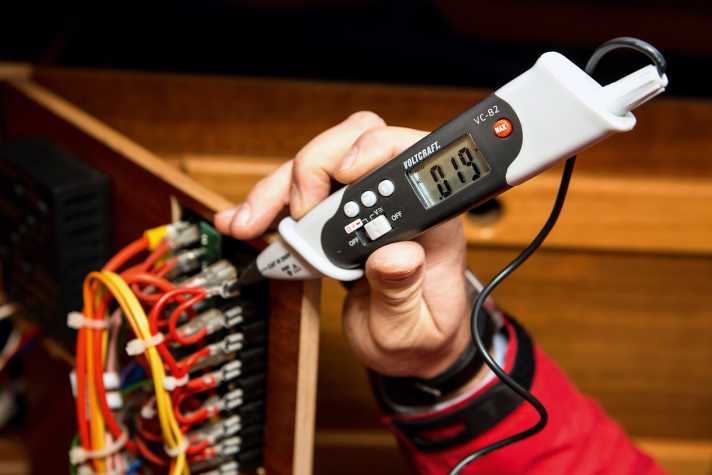
The used boat inspection in the video
The big YACHT used boat special:
- New, used or chartered - here's what to consider
- Which type of boat is the right one? Decision-making aids
- Overview: Used boats under 6 metres
- Overview: Used boats under 7 metres
- Overview: Used boats under 8 metres
- Overview: Used boats around 9 metres
- Overview: Used boats over 9 metres
- Dream yachts: These are the favourite ships of YACHT readers
- Buying a used boat: Your guide through the online jungle
- Own inspection or surveyor? What you need to look out for
- How to avoid traps in the purchase agreement
- The boat is bought - what's next? The first steps
- What insurance do I need for my boat?

